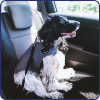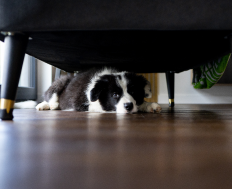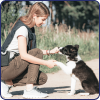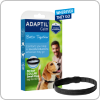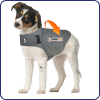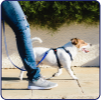
Tips for Training an Older Dog: A Happy Dog Expert Explains!
Although dog training often brings to mind energetic pups starting their learning journey, we should remember that dogs learn throughout their lives. So, whether your dog is 2 or 8 years old, training is still possible. In fact, training can be immensely beneficial for encouraging mental stimulation and deepening your relationship together!
Yes, older dogs will have acquired both good and bad habits over the years, and sometimes the latter are a little more tenacious. But training an older dog isn’t just possible – it can be incredibly rewarding! With a little patience and a lot of love, your senior dog can continue to learn, build confidence and thrive.
When Is A Dog Considered "Old"?
To answer this question, it’s essential to consider several factors, such as the dog's size, breed and physical condition. As these will all play a decisive role when training an older dog.
Large dogs tend to age faster than small dogs. For example, a Yorkie is considered a senior at around 12/13 years of age, whereas for a Labrador it’s at around 8/9. Of course, these are just based on statistics and some dogs may age faster than others.
The most important thing is to observe your older dog, as certain signs like increased tiredness, loss of appetite and difficulty walking can indicate that your dog is beginning to age.
Regular health checks with your vet can help you know what is normal ageing and what may need some medical support. Telling your vet about your dog’s changes in behaviour can help them identify issues.
Some Health Issues Older Dogs Can Face
-
Joint issues – Pain and stiffness from osteoarthritis can make moving around more uncomfortable, so they may be less willing or able to perform certain actions.
-
Vision changes – Changes in eyesight, including the development of cataracts (their pupil may appear whiter than usual), can make it more difficult for an older dog to see and respond to cues.
-
Hearing loss – Losing their hearing over time can impact a dog’s ability to respond to verbal cues.
- Cognitive changes – Canine cognitive dysfunction is like dementia in humans and can impact a dog’s ability to remember and learn things.
Is It Possible to Train an Older Dog?
It can be difficult to know how to train an older dog or whether it’s even possible, but the good news is, it definitely is! It is just important to take into consideration their physical and mental abilities.
Some dogs age very well and are still able to learn despite this, whereas others may need some adaptations. For example, shorter training sessions with rest breaks when needed.
For dogs, training keeps them mentally fit and physically active. Your dog will also enjoy working with you and getting attention, as long as you respect their physical abilities and use appropriate exercises.

Proprioception Focus
As dogs age, they need to maintain their neuronal connections in the brain to help maintain their motor skills. This makes it important to work on your older dog's mind by allowing them to think in situations. To do this, you can set up small proprioception exercises.
What Is Proprioception?
Proprioception is the sense of position and movement of the body. Particularly in the case of an older dog, working on proprioception activities such as maintaining awareness of their hind legs is important and also great exercise.
Of course, it’s key to adapt to your dog's physical abilities. One example of a proprioception activity is the Mikado exercise:
-
Firstly, place bars (such as broom handles) on the ground, angled so they cross over each other.
-
Then, ask your dog to walk carefully among the bars without knocking them over.
-
You can sprinkle treats between the bars to encourage your dog to use their sense of smell along with concentration.
-
If your dog bumps into a bar, it helps them be aware of where their paws are in relation to their body and reminds them to lift them to walk over the bar.
-
Be sure not to stay too long on this exercise – it is recommended to do 2 or 3 passes through the bars several times a week.

Older Dog Training Tips
-
Reduce the length of any training sessions - The first dog training tip when learning how to train an older dog is to focus on short sessions. Older dogs tend to tire more quickly and therefore lose motivation. If you offer them short, fun sessions, they are more likely to remain more focused and energetic during the exercises!
-
Work on small proprioception exercises - The Mikado exercise is a great place to start. Be vigilant about your dog's joints, such as avoiding any balance exercise or tasks at a height that require your dog to climb. You may also want to try exercising them on soft materials such as foam mats to give them more support.
-
Take them on short swims - If your dog likes water, take them for short swims to relax and work their muscles gently. To strengthen your dog’s muscles in the water, it’s better for them to walk in the water at the right depth for walking, not swimming. Be sure to look out for signs of tiredness during training sessions. If your dog is tired stop and opt for shorter, more frequent sessions.
-
Make the experience positive! - Older dogs need more frequent vet visits, so it’s important to help your dog find these experiences as positive as possible. Talk with your vet about ways to reduce your dog’s stress. This might include ‘trial’ visits, where all that happens is your dog receives treats and praise from the clinic team. You can also use ADAPTIL Transport spray for the car journey or have your dog wear a ThunderShirt during the visit to ease their nerves. Many clinics use ADAPTIL Calm diffusers in clinic rooms to help keep dogs calm.
In conclusion, an old dog can learn new tricks! Just remember to be patient, listen to your dog and respond appropriately to their needs. If you are experiencing difficulties training your dog, do not hesitate to contact a local qualified dog trainer for help.
For more great insights into caring for our dogs, check out the rest of our Happy Dog Expert articles online! Or to receive the latest news straight into your inbox, sign up for our email newsletter, and we’ll keep you updated with everything we’re up to.
